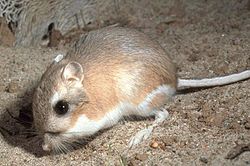| Castorimorpha Temporal range: Early Eocene to Recent | |
|---|---|
 | |
| Ord's kangaroo rat | |
| Scientific classification | |
| Domain: | Eukaryota |
| Kingdom: | Animalia |
| Phylum: | Chordata |
| Class: | Mammalia |
| Order: | Rodentia |
| Suborder: | Castorimorpha Wood, 1955 |
| Extant families | |
Superfamily Castoroidea: Superfamily Geomyoidea: | |
Castorimorpha is the suborder of rodents containing the beavers, gophers and the kangaroo rats. A 2017 study using retroposon markers indicated that they are most closely related to the Anomaluromorpha (the scaly-tailed squirrels and the springhare) and Myomorpha (mouse-like rodents). [1]




